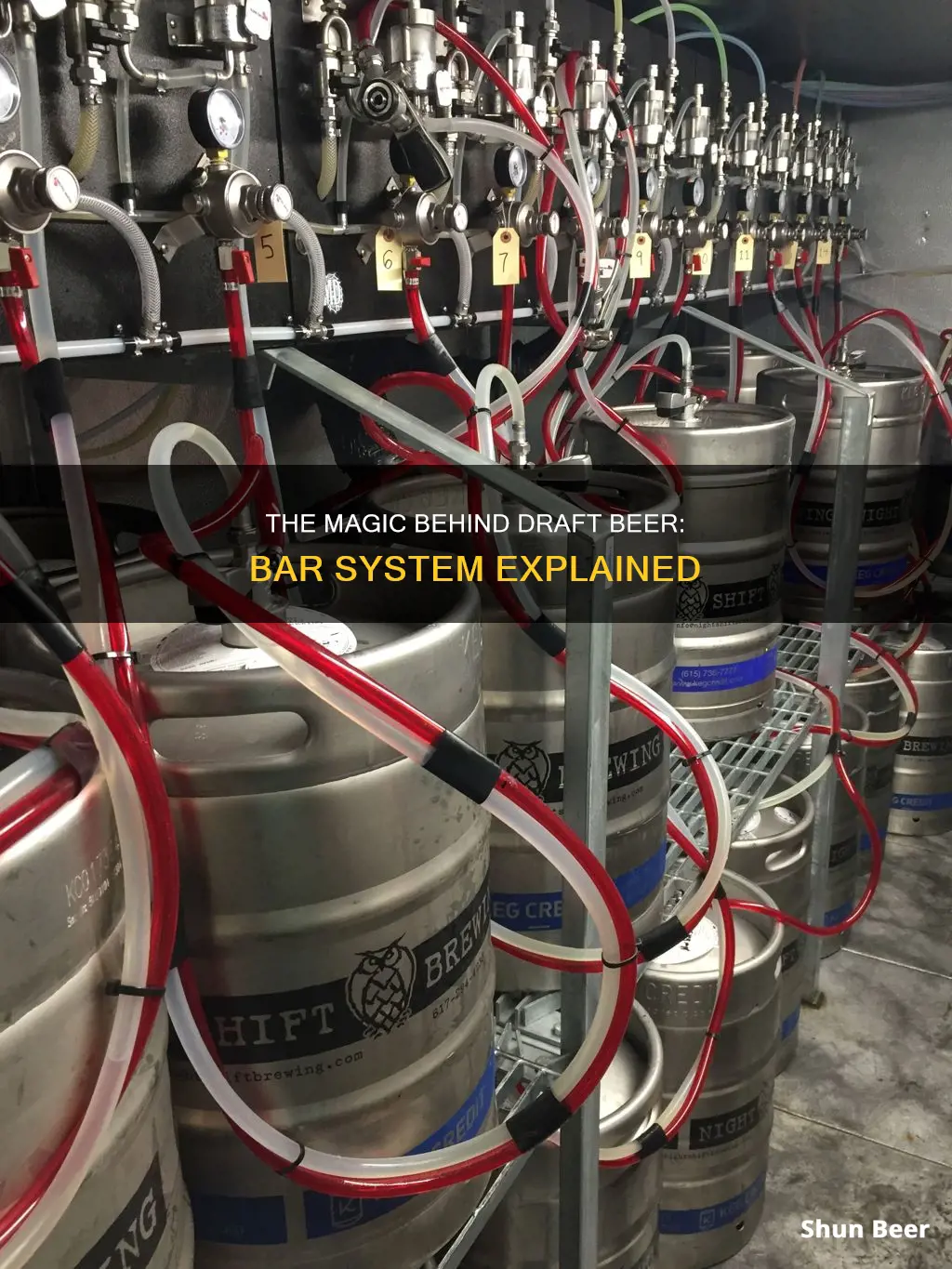
There are a few different types of draft beer systems used in bars, but they all have the same goal: to move the beer from the keg to the faucet as quickly as possible without damaging the product. The three main types of draft beer systems are remote glycol cooled, air-cooled, and direct draw. All three systems use similar pieces of equipment, but each has its own unique components for delivering or cooling draft beer. The essential components of a draft beer system are keg couplers, beer lines, taps, and refrigeration units.
What You'll Learn

Direct draw systems
A direct draw beer system is the most common and straightforward way to dispense draft beer from keg to tap across a short distance. It is often used in bars where the keg is located within a few feet of the dispensing faucet. This system is usually found in commercial keg boxes, refrigerator conversions, and home bars.
A direct draw beer system may be contained within a walk-in cooler, a kegerator, or a converted refrigerator. Kegerators are the most common example of a direct draw system and are often freestanding units that can be placed in the back or front of the bar. They can house single or multiple kegs and are designed to maintain an optimal temperature of 38° F.
Direct-draw beer systems are easy and quick to install, making them a popular choice for smaller establishments or those seeking an economical option. The short distance from the keg to the glass also means that the beer is less likely to lose its chill and there are fewer complications. However, these systems may not be ideal for high-volume bars as they have limited keg spaces and typically no more than eight faucets. Additionally, kegs must be changed where the system is located, which could be in a crowded bar area.
Beer Breakdown: Understanding Its Effect on the Human Body
You may want to see also

Long-draw glycol-cooled systems
A glycol-cooled remote beer system, also known as a long-draw glycol-cooled system, is one of the most popular draft beer systems. It is an excellent choice for any long-draw dispensing setup, typically running 25 feet or longer, due to its ability to maintain a cool temperature and deliver cold beer over long distances.
In a glycol-cooled system, the beer in the keg is kept cold by the cold air in the walk-in cooler. The beer in the beer lines, beer tower, and faucets are kept cold by the continual flow of glycol through the coolant lines. The glycol power pack circulates the glycol coolant from the walk-in cooler to the faucet shank and back to the power pack for re-cooling. The coolant temperature is maintained between 28°F and 34°F by an adjustable thermostat. The glycol power pack then pushes the cold glycol through the supply glycol line, up through the tower behind the faucets, and back to the power pack through the return glycol line, where it is re-cooled and continually pumped back through the system. This keeps the beer at its proper serving temperature.
The trunk housing carries the beer and glycol cooling lines, which are wrapped together using a vapor barrier, foil tape, insulation, and sometimes a barrier jacket. This insulated trunk line consists of multiple beer lines in direct contact with the coolant lines for the entire length of the trunk housing, which can be up to 750 feet or even 1,000 feet in some cases.
Glycol-cooled systems are ideal for long-draw setups where the chiller is at least 75 feet away from the dispensing point. They are commonly used in bars, taverns, pubs, and restaurants to provide cold draft beer to customers.
Beer and Bowel Movements: The Laxative Effect
You may want to see also

Long-draw air-cooled systems
The effectiveness of this type of system depends on the refrigeration temperature. The walk-in cooler must maintain a consistent temperature of 34-38°F. The maximum recommended length for this setup is 25 feet, requiring approximately 1,000 Btu per hour of additional refrigeration capacity. The system can exceed 25 feet, but the number of 90-degree bends in the system must be minimised and the walk-in cooler must not be frequently opened. Each 90-degree bend in the system will result in a loss of cooling efficiency.
A long-draw air-cooled system is less expensive than a glycol-cooled system. It works best on relatively straight shaft runs and only for short, limited distances of less than 25 feet.
The Magical Math of 79 Beers: Age Subtraction Mystery
You may want to see also

Kegerators
A kegerator is a direct draw draft system, the most common example of which is a standard system for delivering draft beer from keg to tap across a short distance. Kegerators are used in bars with a beer keg located within a few feet of the beer-dispensing faucet. They are also used in commercial and home settings.
When it comes to maintenance, it's important to regularly clean your kegerator to ensure the beer is tasting great. Lines left uncleaned are susceptible to the build-up of crud, which can harbour yeast and bacteria that can make your beer taste musty, buttery, or sour.
Hydrometer Basics: Crafting Beer Perfection
You may want to see also

Remote draw systems
A remote draw beer system is where the kegs are stored in a separate area from where the beer is dispensed. Typically, the kegs are kept in walk-in coolers either inside or outside the building. This allows bars or restaurants to store and tap more kegs while keeping them out of the customer's sight.
There are two types of remote draw systems: glycol-cooled and air-cooled. Glycol-cooled systems are the most popular and are used for long-draw dispensing setups, typically running 25 feet or longer. In this system, the beer in the keg is kept cold by the cold air in the walk-in cooler. The beer in the beer lines, beer tower, and faucets are kept cold by the continuous flow of glycol through coolant lines, which maintain a consistent temperature. The glycol power pack is at the heart of the system, as it maintains the temperature of the beer by circulating a glycol mixture alongside the beer lines all the way to the faucet.
Air-cooled systems, on the other hand, use circulating cold air to keep the beer cool in the walk-in cooler, around the beer lines, and up to the faucet. This is a simpler and more cost-effective option for short-draw setups. The beer is stored, chilled, and tapped in the walk-in cooler, and then transferred to the beer faucet through trunk lines at a remote location.
Thermal Beer Mugs: How Do They Keep Drinks Cold?
You may want to see also
Frequently asked questions
The six main components of a draft beer system are the cooler, keg, coupler, gas, tubing, and faucet.
There are three standard systems for dispensing draft beer: direct draw, long-draw glycol-cooled, and long-draw air-cooled.
A direct draw system is typically used when the keg is located close to the tap. Carbon dioxide or a mixture of nitrogen and CO2 (known as beer gas) is used to push the beer from the keg through the beer line to the draft tower and faucet.
A glycol-cooled system is used when the kegs are not refrigerated within close proximity to the draft tower and faucets. It uses a glycol chiller or power pack to pump a mixture of glycol and water through a trunk line, keeping the beer at a consistent temperature as it travels from the keg to the tap.
An air-cooled system uses chilled air blown through a duct containing beer lines to keep the beer cool as it travels from the keg to the tap. This system is typically used for runs of less than 25 feet from keg to tap.







